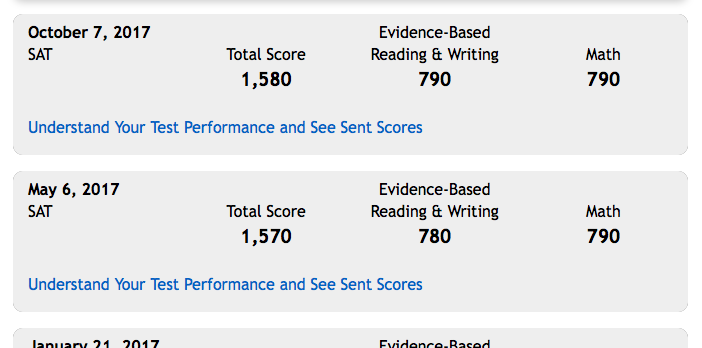I’d spent my Saturday morning taking the SAT 72 times before, but this morning was different. I hadn’t taken an exam in 5 months, which is a very long hiatus for me. Since the College Board redesigned the exam in March of 2016, they only allow non-high school students to take it three times a year: March, May, and October. I used to take the SAT seven times a year, so the new rules make each exam even more important.
This Saturday morning was also strange because I had some peaceful, relaxing time at home before heading to the test center. I arrived at the test center full of focus and energy, exactly how I try to prepare my students to feel right before an exam like this. Most test-takers have an easier time getting that calm morning than I do because I have a 2- and 4-year-old at home. Peace and quiet at 7am is a rare treat! But on October 7th, both girls slept unexpectedly late, and for the first time in forever, Daddy could go to work without breaking any little hearts.
The whole morning went well. I could almost hear my own teaching-voice explaining how to distinguish between two compelling answer choices, how to quickly let go of a question when it isn’t clicking the way it should. I heard that voice remind me that there will always be time later to come back to it with a fresh perspective.
In the grammar section, I started focusing more on getting answers right and less on exploring the test for new insights to share with my students. Maybe it was just my ego, but I wanted to make sure nothing slipped through. After all, this was my 5th opportunity to take the Redesigned SAT, and my best performance thus far on the grammar section had been 42 correct out of 44. I wanted a perfect score.
The math sections come more naturally to me, but I knew not to relax too much even there. No matter what skill they seem to be testing, any question can be deceptive. Something that seems completely straightforward can hide one tiny nuance designed to lead me to the trap answer. Throughout both math sections, my chief concern was to avoid careless mistakes. On my previous four attempts at the Redesigned SAT, I had scored 790 in the math three times. Today was my day to nab those last ten points.
I drove home feeling very good about the exam, and I was excited that results would only take two weeks. I didn’t need my scores for college applications, but still: No one likes waiting.
When score day arrived, I first sat down to reply to a pile of happy emails from my students and their parents. Some of the scores they shared with me were 1400 (680/720 for reading/math), 1440 (740/700), 1480 (690/790), and 1480 (700/780). Obviously, not all of my students did quite that well, but no matter how they did on this exam, they all understood that these scores provides a foundation for their improvement on the next try.
As for me, I was ready to celebrate when I saw the College Board’s email telling me that my scores were available. I logged in, but the only scores I could see were from the May 2017 exam! Frustrating! Two days later I tried again, and there they were:

Those are great scores, but I was still disappointed. This 1580 was the best total score I’ve achieved on the new version, but I hadn’t managed the perfect score I’d achieved several times on the old version of the SAT. Still, I was happy to see that I’d finally answered all 44 Writing and Language questions correctly, losing points only on one of the Reading Test questions. As for the math, I was still stuck at that 790.
I had to remind myself that, though I do strive for a perfect score each time I take the SAT and ACT, that’s not the reason I take them. That’s not the reason I’ve spent nearly 90 Saturdays away from my family taking tests. I do this because I want to prepare my students for the experience. Succeeding on these exams is so much more than just learning how to answer every question type. It’s being able to get the job done on test day despite all of the anxiety surrounding an exam that is expertly designed to encourage careless mistakes.
So, while I was sad to end up with another imperfect score, it was still a morning well spent. As I began teaching another round of classes the following week, my experiences from another 4-hour test were fresh in my mind, informing all of the strategies and methodologies I taught my students.
And as I began preparing my students for the next exam, I could hear my teaching-voice in the back of my head, reminding me that for me, too, there’s always next time.


